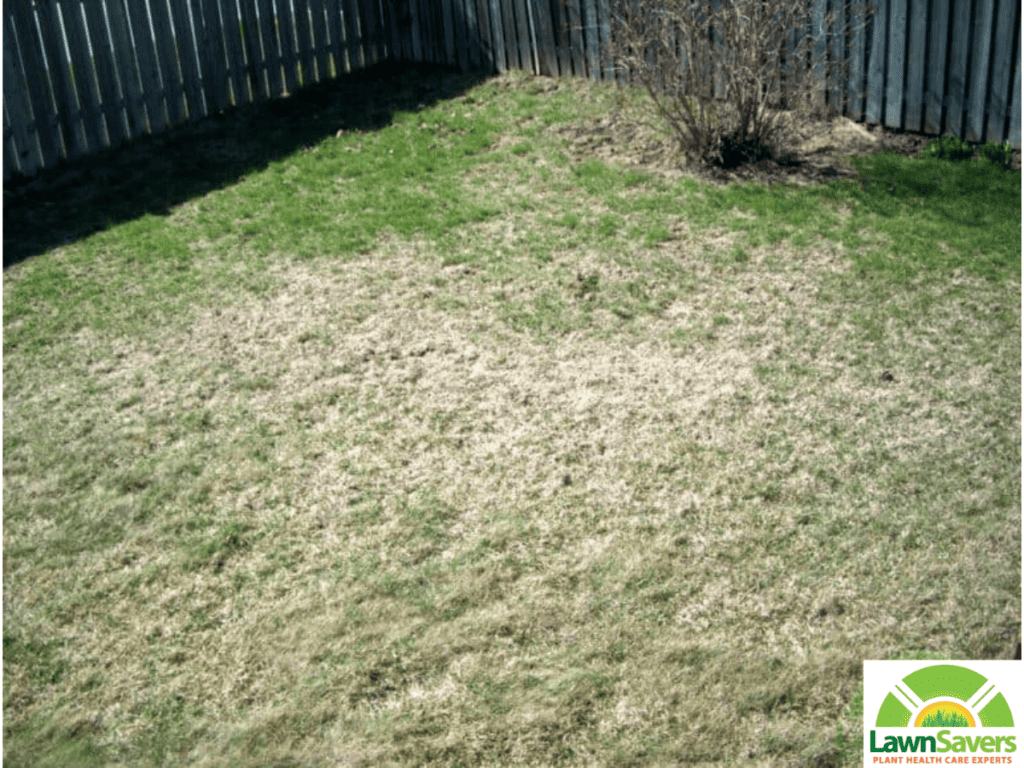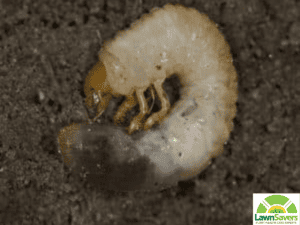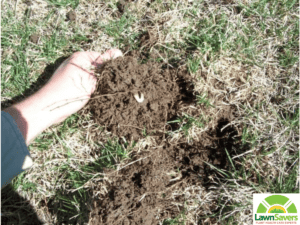TL;DR
- Identification: White grubs are the larvae of beetles like European Chafers and Japanese Beetles. They feed on grass roots, causing lawns to turn brown and feel spongy.
- Damage Signs: Affected grass pulls up easily, resembling loose carpet. In spring, animals such as raccoons and skunks may dig up lawns to feed on these grubs, exacerbating the damage.
- Prevention: Maintain a healthy lawn with deep, strong roots through proper watering and professional fertilization. This enhances the lawn’s tolerance to grubs.
- Control Measures: Apply predatory nematodes in late August to early October to naturally reduce grub populations.
- Repair: After addressing the grub issue, repair damaged areas by overseeding and maintaining consistent lawn care practices.
 Grub damage is typically caused in the spring and is the end result of hungry insects attacking lawns in the previous fall, coupled with raccoons and skunks digging up the lawn to look for them and eat them. Preventative grub control treatment and good lawn care practices can minimize the risk of grub damage happening on your property.
Grub damage is typically caused in the spring and is the end result of hungry insects attacking lawns in the previous fall, coupled with raccoons and skunks digging up the lawn to look for them and eat them. Preventative grub control treatment and good lawn care practices can minimize the risk of grub damage happening on your property.
What Does Grub Damage Look Like In A Lawn?
In the fall many Toronto lawns in the GTA (like Barrie, King City or Oakville become prey to root-eating insects called white grubs. The targeted turf fades in colour as fall progresses and the injured roots cannot absorb nutrients or water properly. Your lush green grass will turn brown and withered.
The damaged areas begin to feel soft and spongy underfoot and pull out easily (like carpet) because the cut roots can no longer hold the grass plants to the soil.
 What Do White Grubs Look Like?
What Do White Grubs Look Like?
White grubs are the larva, or young, of several kinds of beetles. The European Chafer (Rhizotrogus majalis) and Japanese Beetle (Popillia japonica) are two of the most common in the Toronto area and throughout Ontario.
The adults breed through the early Summer and lay eggs in your lawn, which hatch in mid-to late-August and begin to feed, causing grub damage to occur.
 Will Grub Damage Get Worse If Not Repaired?
Will Grub Damage Get Worse If Not Repaired?
In the spring when food is scarce, scavenging animals like raccoons and skunks find grubs an easy source of nutrition. Since the grubs have already eaten the roots, it is easy for the animals to roll your grass back like new sod, causing it even more damage than the grubs themselves.
Even if you do not have many grubs in your lawn, these animals often dig in places they remember finding food before. Squirrels sometimes cause small fist-sized dug up areas, however, are rarely the cause of a ripped up lawn as they are mainly herbivores and will only eat insects if starved (which rarely happens with all the buds and seeds available in the spring)
How Do I Get Rid of White Grubs In My Lawn?
Trust the grass experts at LawnSavers, Proactive Preventive care works best!
All lawns have some grubs. While it is impossible to eliminate all grubs from a lawn, the objective is to reduce the number of grubs so that a lawn can outgrow any damage. Damage happens if a lawn becomes weak with poor root growth, and/or the number of grubs is very high (more than five to ten per square foot on an average lawn). Watering for an hour and a half to two hours once a week and having your lawn professionally fertilized will make your grass grow deeper, stronger roots and regenerate injured roots faster, limiting grub damage. It will also increase your lawn’s tolerance level for grubs. Learn more science behind grub control here.
LawnSavers can apply a natural grub control called ‘Predatory Nematodes’ to your lawn around mid-August to early September, up until early October. These microscopic creatures are applied in the hundreds of millions and swim through moist soils to attack and infect the grubs they can find. Stopping grub damage from occurring, and reducing grub populations. It is important to know that no Chemical or Natural grub control can eliminate all grubs!
Digging animals can also be deterred in many ways, from fencing to smells they don’t like. Many of our clients have told us they are having good luck with motion-activated sprinklers, such as the ‘Scarecrow’.
These techniques will minimize damage from white grubs. Nature being unpredictable, some may still occur, especially since skunks and raccoons are creatures of habit. Animals digging is a clue that you might have grubs, but not definitive proof as squirrels and other animals can scavenge and dig for reasons other than finding grubs.
How To Repair A Grub Damaged Lawn
If grub damage has occurred despite your best efforts, immediate repair is needed to prevent further problems later. Following these simple steps can help to repair grub-damaged lawns.
- Rake out any loose, dead grass.
- Have a local qualified lawn care company do an aeration and overseeding of your lawn with the proper species of grass.
- If animals have flipped up to grass when digging, don’t despair. Wet the flipped turf to soften it and roll it back into place – if your grass is generally healthy there is a good chance that it will re-root, just like sod.
- Follow the preventative suggestions above to keep further grub damage from occurring your newly repaired lawn.
FAQ About Best Lawn Care Practices
🌱 How Many Times a Week Should You Water Your Lawn?
You need to water at least once a week for at least an hour, this generally provides 1-1.5″ of water to the roots (a tuna cans height) (exceptions: 1. when you seed & 2. if you have an automated system 3. When we are experiencing extreme heat).
New Seeding Watering: Seed must be kept moist until established. This will be influenced by the amount of sun, wind and heat you are experiencing in your particular area. It is normal to require 3-4 short waterings per day to maintain a moist seedbed. Use a light stream of water to lessen disturbance of the seedbed.
🌱 What is Aeration?
Natural aeration is the process of air exchange between the soil and its surrounding atmosphere. Sometimes this process needs a little help, and that is where liquid aeration, the process of either applying a blend of soil enhancing materials OR mechanically removing small plugs of thatch and soil from the lawn, is used to improve soil aeration.
🌱 How Do You Care For A Newly Sodded Lawn?
For a newly sodded lawn, it is very important to make sure you water your lawn every morning and night for the first two weeks, make sure you mow it at your mower’s highest setting and limit traffic to keep the lawn from getting lumpy.
Additional Tips: See this article from the lawn care experts at LawnSavers to see how short you should cut your grass before winter.
Check out what Barbara had to say about her grub service on Google:
“LawnSavers was recommended by neighbours when I first noticed turf repeatedly dig up by skunks searching for the scrumptious grubs I was encouraging to take up residence in my lawn! LawnSavers took care of it promptly and successfully. For years I have been hand-weeding but not fertilizing and scorned chemical treatments but was so impressed by all interactions with LawnSavers & their technicians that I have signed up for their Protection service for the past few years and my lawn has improved and never looked better! Now that it looks great and grubs are gone I just need to discourage the neighbourhood dogs from decorating my lawn – but there’s no help for that!”
Rating: 5/5
Date: 2018-02-28









